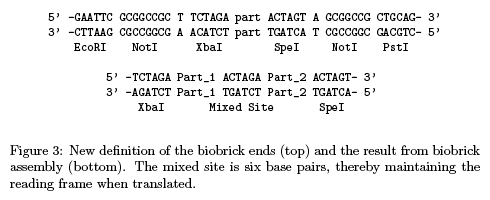Plasmid backbones/Assembly of protein fusions
| Part assembly | System operation | Protein expression | Assembly of protein fusions | Part measurement | Screening of part libraries | Building BioBrick vectors | DNA synthesis | Other standards | Archive |
| Or get some help on plasmid backbones. |
Protein engineers often need to do in-frame assemblies in order to assemble together different signal sequences, proteins domains, and protein tags. BioBrick™ standard assembly is not well-designed for this task because the scar sequence formed by the SpeI-XbaI ligation is 8 base pairs long, so assembly of protein domains causes frameshifts. As a result, different groups have developed modified or alternative assembly schemes to facilitate assembly of protein domains.
Plasmids that adhere to the Silver standard
Pam Silver's lab has developed the Silver standard for assembling protein domains. It relies on shortening the BioBrick prefix and suffix each by 1 base pair such that the resulting SpeI-XbaI scar is only 6 base pairs long and protein domains can be assembled in frame.
As shown in the figure 3 (right), the Silver standard results in the inclusion of a Thr-Arg (ACT AGA) two amino acid junction between protein domains.
One disadvantage of the Silver standard is that the codon AGA which encodes Arginine is a rare codon in E. coli. Rare codons can prevent over-expression of proteins in E. coli.
There are no parts for this table
References
A New BioBrick Assembly Strategy Designed for Facile Protein Engineering
MIT SBWG Technical Reports, 2006 Apr 20
Ira Philips, Pam Silver
[http://hdl.handle.net/1721.1/32535 URL] (open access!)












